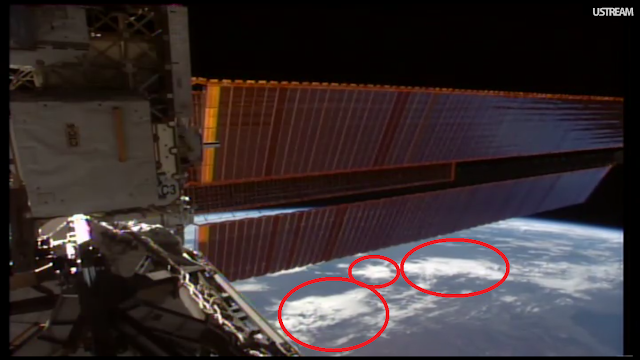Similar to my previous experiment, we’re going to test the Himawari-8 satellite again but this time with the live stream onboard the International Space Station and compare cloud patterns in the images from both satellites to see if they match up.
However, doing so will be difficult. The ISS is in low earth orbit about 400 kilometers above the planet's surface, while the Himawari-8 is in geostationary orbit so it will always be above the same place on earth, about 35,786 kilometers above the earth’s surface.
Since the Himawari-8 satellite is always in the same place and the ISS is always in a different place because of it’s ~90 minute orbit while also changing because of the rotation of the earth, we need to find an exact time when the ISS livestream shows cloud formations above the asian-pacific region at around the same time the Himawari-8 takes a picture so that we can compare the clouds.
And, we got it.
On the 20th of May 2017, the ISS flew over a location near Perth, Australia and showed some of the clouds over the western australia state. 3 minutes later, the Himawari-8 satellite took a picture like it normally does. Let’s compare the clouds!
(Keep in mind that this image is flipped upside down for the himawari-8 satellite image which was originally the right way up.)

Okay, you see these two clouds, here?
Remember those. They will be important in a moment.
Okay. Now that we’ve got our flipped ISS image, let’s take a look at an image of western australia that was taken literally 3 minutes after the ISS one.
Unedited:
Edited:
Woops! Lookie here, flat earthers! The same clouds in the Japanese image as in the ISS image!
Now, let’s think of occam's razor:
Scenario 1:
Almost every day, the american and japanese governments matchup cloud patterns with each other on the off chance that someone (like me) is going to check and see if they match up. Not only this, they did it in a super secret way that it would NEVER leak onto the internet in the timespan of 2 entire years, and many more years to come.
Scenario 2:
The ISS, (a real satellite), passed over an area and filmed an area which the Himawari-8 (also a real satellite) took a picture of like it normally does at around the same time and therefore showed the same clouds.
If you ask me, scenario 2 seems far more likely and easier to do. Scenario 1 is obviously the scenario flat earthers are gonna take, and it’s a very silly scenario how I look at it.
Now of course, you don’t have to take my word for it. The stream I took the snapshot from is a flipped image from this livestream:
At exactly 2:19:54. Check yourself and flip your head upside down, the clouds are there.
As for the Himawari-8, go onto the website and set the date and time to the 20th May 2017 at 12:30 PM Sydney time. The clouds are there too, of course when you look at the area around Perth, western australia.
Now, time to do the experiment once again. This one actually went a little better this time, because there were less clouds and therefore I could make out the patterns easier.
This one happened a day later, on the 21st of May 2017 at exactly 10 AM Sydney time, in the New South Wales state of Australia. The ISS passed over the exact time the picture was taken, instead of a 3 minute delay.
This time, let’s take a look at the Himawari-8 image first to see what we’re dealing with:
Okay. These are the clouds I want you to keep an eye out when I give you the ISS image in a moment:
(I’ll flip the image 90 degrees because the ISS image was also 90 degrees).
Here are the original images (Himawari-8 has been cropped and flipped):
And here are the images with the appropiately circled clouds:
Again, don’t take my word for it! This ISS image above was taken from this video:
Shortly after 2:51:00.
Himawari-8? Go onto the website again, and go to the 21st of May 2017 at exactly 10 AM Sydney time, and look at the New South Wales state of Australia. (East coast) The clouds will be there, exactly as seen in the livestream.
(Also, I must note that the clouds look a little bit different in the ISS stream most of the time because the ISS is closer to the earth and is therefore looking at the clouds at an angle while the Himawari-8 is directly above).
Now, flat earthers. I challenge you to do what I did: Find a time when the ISS is passing over Australia or anywhere in the Himawari-8 area and screenshot two times from both satellites that were taken at around the same time and compare the clouds. (Flip screenshots if necessary, and you can track the ISS with this website).
(Also, final note, I need to point out that the ISS live stream organises it’s saved videos by EDT time so remember to convert it to sydney time by using this website).








No comments:
Post a Comment